Related Research Articles

An estuary is a partially enclosed coastal body of brackish water with one or more rivers or streams flowing into it, and with a free connection to the open sea.

A lagoon is a shallow body of water separated from a larger body of water by barrier islands or reefs. Lagoons are commonly divided into coastal lagoons and atoll lagoons. They have also been identified as occurring on mixed-sand and gravel coastlines. There is an overlap between bodies of water classified as coastal lagoons and bodies of water classified as estuaries. Lagoons are common coastal features around many parts of the world.
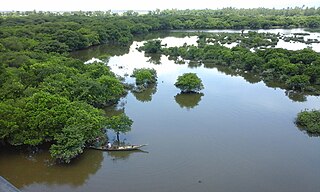
A wetland is a distinct ecosystem that is flooded by water, either permanently or seasonally, where oxygen-free processes prevail. The primary factor that distinguishes wetlands from other land forms or water bodies is the characteristic vegetation of aquatic plants, adapted to the unique hydric soil. Wetlands play a number of functions, including water purification, water storage, processing of carbon and other nutrients, stabilization of shorelines, and support of plants and animals. Wetlands are also considered the most biologically diverse of all ecosystems, serving as home to a wide range of plant and animal life. Whether any individual wetland performs these functions, and the degree to which it performs them, depends on characteristics of that wetland and the lands and waters near it. Methods for rapidly assessing these functions, wetland ecological health, and general wetland condition have been developed in many regions and have contributed to wetland conservation partly by raising public awareness of the functions and the ecosystem services some wetlands provide.
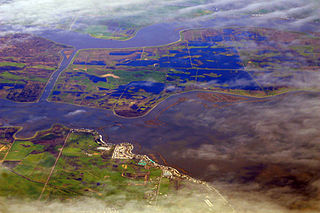
A river delta is a landform created by deposition of sediment that is carried by a river as the flow leaves its mouth and enters slower-moving or stagnant water. This occurs where a river enters an ocean, sea, estuary, lake, reservoir, or another river that cannot carry away the supplied sediment. The size and shape of a delta is controlled by the balance between watershed processes that supply sediment, and receiving basin processes that redistribute, sequester, and export that sediment. The size, geometry, and location of the receiving basin also plays an important role in delta evolution. River deltas are important in human civilization, as they are major agricultural production centers and population centers. They can provide coastline defense and can impact drinking water supply. They are also ecologically important, with different species' assemblages depending on their landscape position.

A salt marsh or saltmarsh, also known as a coastal salt marsh or a tidal marsh, is a coastal ecosystem in the upper coastal intertidal zone between land and open saltwater or brackish water that is regularly flooded by the tides. It is dominated by dense stands of salt-tolerant plants such as herbs, grasses, or low shrubs. These plants are terrestrial in origin and are essential to the stability of the salt marsh in trapping and binding sediments. Salt marshes play a large role in the aquatic food web and the delivery of nutrients to coastal waters. They also support terrestrial animals and provide coastal protection.

Narragansett Bay is a bay and estuary on the north side of Rhode Island Sound covering 147 mi2 (380 km2), 120.5 mi2 (312 km2) of which is in Rhode Island. The Bay forms New England's largest estuary, which functions as an expansive natural harbor and includes a small archipelago. Small parts of it extend into Massachusetts.
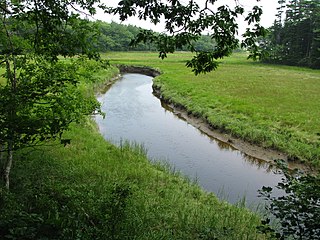
A tidal marsh is a marsh found along rivers, coasts and estuaries which floods and drains by the tidal movement of the adjacent estuary, sea or ocean. Tidal marshes experience many overlapping persistent cycles, including diurnal and semi-diurnal tides, day-night temperature fluctuations, spring-neap tides, seasonal vegetation growth and decay, upland runoff, decadal climate variations, and centennial to millennial trends in sea level and climate. They are also impacted by transient disturbances such as hurricanes, floods, storms, and upland fires.

An aquatic ecosystem is an ecosystem in a body of water. Communities of organisms that are dependent on each other and on their environment live in aquatic ecosystems. The two main types of aquatic ecosystems are marine ecosystems and freshwater ecosystems.

Yaquina Bay is a coastal estuarine community found in Newport, Oregon, United States. Yaquina Bay is a semi-enclosed body of water, approximately 8 km² (3.2 mi²) in area, with free connection to the Pacific Ocean, but also diluted with freshwater from the Yaquina River land drainage. The Bay is traversed by the Yaquina Bay Bridge. There are three small communities that border the Yaquina River and Bay; Newport, Toledo and Elk City. The Yaquina Bay in Newport is a popular tourist destination along the Pacific Coast Highway. It is also an important estuary for the ecology and economy of the area.
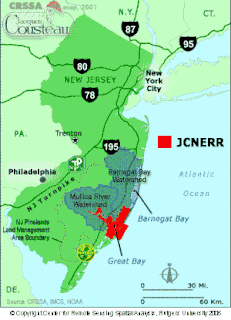
The Jacques Cousteau National Estuarine Research Reserve, located in southeastern New Jersey, encompasses over 110,000 acres (450 km²) of terrestrial, wetland and aquatic habitats within the Mullica River-Great Bay Ecosystem.

The St. Lucie River is a 7-mile-long (11 km) estuary linked to a coastal river system in St. Lucie and Martin counties in the Florida, United States. The St. Lucie River and St. Lucie Estuary are an "ecological jewel" of the Treasure Coast, central to the health and well-being of the surrounding communities. The river is part of the larger Indian River Lagoon system, the most diverse estuarine environment in North America with more than 4,000 plant and animal species, including manatees, oysters, dolphins, sea turtles and seahorses.

Lake Connewarre, a shallow estuarine 880-hectare (2,200-acre) lake on the Barwon River, is located on the Bellarine Peninsula southeast of Geelong in the Australian state of Victoria.

The San Francisco Estuary together with the Sacramento–San Joaquin River Delta represents a highly altered ecosystem. The region has been heavily re-engineered to accommodate the needs of water delivery, shipping, agriculture, and most recently, suburban development. These needs have wrought direct changes in the movement of water and the nature of the landscape, and indirect changes from the introduction of non-native species. New species have altered the architecture of the food web as surely as levees have altered the landscape of islands and channels that form the complex system known as the Delta.
A tidal prism is the volume of water in an estuary or inlet between mean high tide and mean low tide, or the volume of water leaving an estuary at ebb tide.
Eprapah Creek is a sub-tropical stream located in Redland City close to Brisbane in South East Queensland, Australia.
Estuarine water circulation is controlled by the inflow of rivers, the tides, rainfall and evaporation, the wind, and other oceanic events such as an upwelling, an eddy, and storms. Estuarine water circulation patterns are influenced by vertical mixing and stratification, and can affect residence time and exposure time.
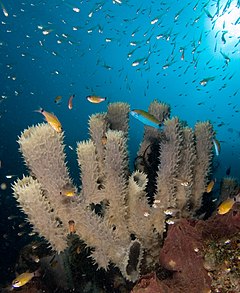
Marine habitats are habitats that support marine life. Marine life depends in some way on the saltwater that is in the sea. A habitat is an ecological or environmental area inhabited by one or more living species. The marine environment supports many kinds of these habitats.

A tidal barrage is a dam-like structure used to capture the energy from masses of water moving in and out of a bay or river due to tidal forces.
Estuarine acidification happens when the pH balance of water in coastal marine ecosystems, specifically those of estuaries, decreases. Water, generally considered neutral on the pH scale, normally perfectly balanced between alkalinity and acidity.While ocean acidification occurs due to the ongoing decrease in the pH of the Earth's oceans, caused by the absorption of carbon dioxide (CO2) from the atmosphere, pH change in estuaries is more complicated than in the open ocean due to direct impacts from land run-off, human impact, and coastal current dynamics. In the ocean, wave and wind movement allows carbon dioxide (CO2) to mixes with water (H2O) forming carbonic acid (H2CO3). Through wave motion this chemical bond is mixed up, allowing for the further break of the bond, eventually becoming carbonate (CO3) which is basic and helps form shells for ocean creatures, and two hydron molecules. This creates the potential for acidic threat since hydron ions readily bond with any Lewis Structure to form an acidic bond. This is referred to as an oxidation-reduction reaction.
Nutrient cycling in the Columbia River Basin involves the transport of nutrients through the system, as well as transformations from among dissolved, solid, and gaseous phases, depending on the element. The elements that constitute important nutrient cycles include macronutrients such as nitrogen, silicate, phosphorus, and micronutrients, which are found in trace amounts, such as iron. Their cycling within a system is controlled by many biological, chemical, and physical processes.
References
- 1 2 3 4 Montagna, P.A.; Palmer, T.; Pollack, J. (2013). Hydrological Changes and Estuarine Dynamics. SpringerBriefs in Environmental Science. 8. p. 94. doi:10.1007/978-1-4614-5833-3. ISBN 978-1-4614-5832-6.
- ↑ Sumich, J.L. (2004). An Introduction to the Biology of Marine Life, Sixth Edition. Jones and Bartlett Learning. p. 449. ISBN 9780763733131.
- 1 2 National Oceanic and Atmospheric Administration (NOAA). "Estuaries". NOAA.
- 1 2 D'Elia, C.F.; Sanders, J.G.; Boynton, W.R. (1986). "Nutrient Enrichment Studies in a Coastal Plain Estuary: Phytoplankton Growth in Large-Scale, Continuous Cultures". Canadian Journal of Fisheries and Aquatic Sciences. 43 (2): 397–406. doi:10.1139/f86-050.
- ↑ Keith R. Dyer & Robert Joseph Orth (1994). The influence of Atchafalaya River discharge on Fourleague Bay, Louisiana (USA) found in:Changes in Fluxes in Estuaries. Fredensborg, Denmark: Olsen and Olsen. pp. 151–160. ISBN 9788785215222.
- ↑ Costanza, R.; d'Arge, R.; de Groot, R.; Farber, S.; Grasso, M.; Hannon, B.; Limburg, K.; Naeem, S.; O'Neill, R. V.; Paruelo, J.; Raskin, R. G.; Sutton, P.; van den Belt, M. (1997). "The Value of the World's Ecosystem Services and Natural Capital" (PDF). Nature. 387 (6630): 253–260. doi:10.1038/387253a0. Archived from the original (PDF) on 2012-07-30.
- ↑ "Comparative Analysis of Marine Ecosystems Organization (CAMEO)". CAMEO.
- ↑ Millennium Ecosystem Assessment (2005). "Ecosystems and Human Well Being: Current State and Trends" (PDF). Island Press. 1: 47.
- ↑ Crossland, C.J.; et al. (2005). Coastal Fluxes in the Anthropocene. Global Change - the IGBP Series. Berlin, Germany: Springer-Verlag. p. 232. ISBN 978-3-540-27851-1.
- ↑ Montagna, P.A.; Kalke, R. D.; Ritter, C. (2002). "Effect of Restored Freshwater Inflow on Macrofauna and Meiofauna in Upper Rincon Bayou, Texas, USA". Estuaries. 25 (6): 1436–1447. doi:10.1007/bf02692237. JSTOR 1352870.
- ↑ Kim, H. C.; Montagna, P. A. (2009). "Implications of Colorado River Freshwater Inflow to Benthic Ecosystem Dynamics: A Modeling Study". Estuarine, Coastal and Shelf Science . 83 (4): 491–504. doi:10.1016/j.ecss.2009.04.033.
- ↑ Alber, Merryl (December 2002). "A Conceptual Model of Estuarine Freshwater Inflow Management" (PDF). Estuaries. 25 (6B): 1246–1261. doi:10.1007/bf02692222.
- ↑ Adams, J.B.; Bate, C. G.; Harrison, T.D.; Huizinga, P.; Taljaard, S.; Niekerk, L. V.; Plumstead, E. E.; Whitfield, A.K.; Wooldridge, T. H. (December 2002). "Estuaries and Application to the Mtata Estuary, South Africa". Estuaries. 25 (6B): 1382–1393. doi:10.1007/bf02692232.
- ↑ Chamberlain, R.H.; Doering, P.H. (1998). "Preliminary Estimate of Optimum Freshwater Inflow to the Caloosahatchee Estuary: A Resource Based Approach. In S. F. Treat (ed.), Proceedings of the 1997 Charlotte Harbor Public Conference and Technical Symposium" (PDF). South Florida Water Management District and Charlotte Harbor National Estuary Program. Technical Report No. 98-02: 121–130. Archived from the original (PDF) on 2010-06-17.
- ↑ Arkema, K.K.; Abramson, S.C.; Dewsbury, B.M. (2006). "Marine Ecosystem-Based Management: From Characterization to Implementation" (PDF). Frontiers in Ecology and the Environment. 4 (10): 525–532. doi:10.1890/1540-9295(2006)4[525:memfct]2.0.co;2.
- ↑ Hutchison, L.M. (2011). Master's Thesis: Stakeholder Perceptions of Ecosystem Services of Coastal Habitats. Corpus Christi, TX: Texas A&M University- Corpus Christi. p. 107.
- ↑ Tharme, R.E. (2003). "A Global Perspective on Environmental Flow Assessment: Emerging Trends in the Development and Application of Environmental Flow Methodologies for Rivers". River Research and Applications. 19 (5–6): 397–441. doi:10.1002/rra.736.
- Montagna, P.A.; Alber, M.; Doering, P.; Connor, M.S. (2002). "Freshwater Inflow: Science, Policy, Management". Estuaries. 25 (6): 1243–1245. doi:10.1007/bf02692221.
- Palmer, T.A.; Montagna, P.A.; Pollack, J.B.; Kalke, R.D.; Deyoe, H.R. (2011). "The Role of Freshwater Inflow in Lagoons, Rivers, and Bays". Hydrobiologia. 667 (1): 49–67. doi:10.1007/s10750-011-0637-0.
- Palmer, T.; Montagna, P.A.; Kalke, R.D. (2008). "Benthic Indications of the Initial Effect of Opening a Channel at Packery Channel". Environmental Bioindicators. 3 (3–4): 205–206. doi:10.1080/15555270802551776.
- Montagna, P.A.; Kalke, R. D.; Ritter, C. (2002). "Effect of Restored Freshwater Inflow on Macrofauna and Meiofauna in Upper Rincon Bayou, Texas, USA". Estuaries. 25 (6): 1436–1447. doi:10.1007/bf02692237. JSTOR 1352870.
- Montagna, P.A.; Palmer, T.; Pollack, J. (2013). Hydrological Changes and Estuarine Dynamics. SpringerBriefs in Environmental Science. 8. p. 94. doi:10.1007/978-1-4614-5833-3. ISBN 978-1-4614-5832-6.